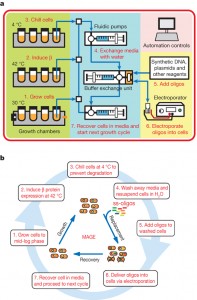Aug
4
High Speed Genetic Modification
August 4, 2009 | 1 Comment
High-throughput sequencing machines have turned biologists into voracious genome readers, enabling them to scan millions of DNA letters, or bases, every hour. The problem is knowing what genes do just what and what rewrites will make the difference hoped for.
It’s like a writers block. Struggling to come up with the story. That struggle is also burdened with outdated gene programming technology, a field that hasn’t kept up with sequence building. That makes preparing new sequences a long slow and tedious process.
Harvard University Medical School researchers have devised a novel cell programming method that retools evolution to generate genetic diversity at an unprecedented rate. Their first success turned a self-serving bacteria into efficient factories for making a variety of compounds. The team managed in just three days to complete a new sequence that would take biotech companies many months or years. The newly transformed bacteria produced five times more lycopene (an anti-cancer antioxidant found commonly in tomatoes) than the original bacteria.
The new cell programming method enables scientists to use information about particular genes and pathways to rapidly refine the genomes of organisms for specific purposes. The technology can efficiently tweak the genome of a bacterium to enhance production of a particular compound, such as a dietary supplement, therapeutic compounds or biofuels. That’s the short list.
The Harvard team’s new cell programming method is called Multiplex Automated Genome Engineering (MAGE). Their paper was published online in Nature on July 26, where the programming platform promises to give biotechnology, in particular synthetic biology a powerful boost.
The team rapidly refined the design of the bacterium by editing multiple genes in parallel instead of targeting one gene at a time. Graduate student Harris Wang, the paper’s co-first author, explains, “We initiated the project to close the gap between DNA sequencing technology and cell programming technology.”
Postdoctoral researcher Farren Isaacs, the other first co-author says, “The goal was to use information gleaned from genetics and genomics to rapidly engineer new functions and improve existing functions in cells. We wanted to develop a new tool and demonstrate how to apply it; we were determined to hand laboratories a hammer and a nail.” The key was to break free of linear genetic engineering techniques and move beyond the serial manipulation of single genes.
This development is really quite significant. The rate of sequence programming has just increased exponentially. The technology should transfer across a wide range of productive species.
First, the team selected a harmless strain of the intestinal nemesis E. coli and added a few genes to its solitary circular chromosome, coaxing the organism to produce lycopene, a powerful antioxidant that occurs naturally in vegetables. Then they could focus on tweaking the cells to increase the yield of this compound with the parallel approach.
Usually laboratories will do this type of transformation by using recombinant DNA technology, also known as gene cloning, a complicated technique that involves isolating, breaking up, reassembling, and then reinserting genes. The Harvard team takes a different approach, blending an engineer’s logic with a biologist’s appreciation for complexity. “Genes function in teams, not in isolation,” says Wang. “Cloning often encourages us to ignore the interdependence of genes and oversimplify the cellular system. We might forget, for example, that one mutation can strengthen or weaken the effects of another mutation.”
Very smart guys, indeed. Isaacs says, “It’s nearly impossible to predict which combinations of mutations will confer the desired behavior. Biology is so complex that we don’t know the optimal solution.”
That makes the Harvard technology a “remaking of evolution” – generate genetic diversity at an unprecedented rate, increasing the odds of finding cells with desirable properties.
The team focused on 24 of the E. coli bacterium’s approximately 4,500 genes building a pathway with tremendous potential to increase production of the antioxidant, optimizing the sequences simultaneously. Taking the 24 DNA sequences, divided them up into manageable 90-letter segments, and modified each, so generating a suite of genetic variants. Then, armed with the specific sequences, the team enlisted a company to manufacture the thousands of unique constructs. The team was then able to insert these new genetic constructs back into the cells, allowing the natural cellular machinery to absorb this revised genetic material.
Thus some bacteria ended up with one constructed program, some ended up with multiple constructed programs. The resulting pool contained an assortment of cells, some better at producing lycopene than others. The team extracted the best producers from the group and repeated the process over and over to further hone the manufacturing machinery. To make things easier, the researchers automated all of these steps.
Wang says, “We accelerated evolution, generating as many as 15 billion genetic variants in three days and increasing the yield of lycopene by 500 percent. Can you imagine how long it would take to generate 15 billion genetic variants with traditional cloning techniques? It would take years.” OK, calmly now, no one has accelerated evolution. These researchers have devised a fast track to making new species.
The team’s new programming method is a new generation itself in the synthesis of new species that can be engineered to make an incredible array of chemical compounds. The new possibilities seem endless today.
What really matters is the new speed to determine the sequences that get to the goals. As noted above some projects can take years and this new process looks to cut that down to much shorter time frames. Another aspect is from those groups of engineered species, the other new attributes that can appear. What turns up to the careful observers might well be bigger news than anyone might imagine today.
Comments
1 Comment so far



I think every one of those researchers should be forced to read The Andromeda Strain before they start work.